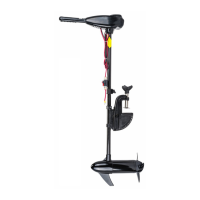• The charger is for indoor use only.
GENERAL THOUGHTS
and) Before starting the engine for the first time, read this manual carefully to familiarize yourself with all its
features and functions, safety requirements, and operation and maintenance.
Before each cruise, the so-called daily inspection
Never run the engine indoors. Exhaust gas contains poisonous carbon monoxide that can lead to
unconsciousness or even death. Never use a boat while under the influence of alcohol or drugs.
Test your boat at low and medium speeds until you learn how to operate it thoroughly and understand its
behavior in different situations. Never run the boat at full speed unless you are completely familiar with the
boat's behavior in the water. Make sure all passengers on board wear life jackets. When loading the boat,
make sure the weight is distributed evenly. Respect the inspection intervals
Do not make any alterations or modifications to the engine or its components. This may damage the engine
and result in an accident.
Familiarize yourself with and follow the shipping regulations for the area in which you intend to sail.
Make sure you have the appropriate emergency and signaling equipment such as: life jackets for each
passenger, light flares, fire extinguisher, anchor, oar, bilge pump, rope, medical first aid kit, tool kit,
emergency start rope, fuel, oil, etc. .
Instruct all passengers in the event of an emergency. Make sure they know the rules of operating the boat,
they can
Use emergency equipment and know what to do in case of problems.
Do not step on the cowl or any other part of the boat when getting on or off the boat.
Check the weather forecast before starting your cruise.
Pay particular attention when replacing any engine parts or selecting and installing additional equipment.
The use of non-original or poor-quality parts may damage the engine and lead to a hazard. The use of
non-original parts will result in the immediate loss of warranty.
b)
c)
d)
e)
f)
g)
h)
and)
j)
k)
l)
m)
n)
about)
p)
WIRING AND BATTERY INFORMATION
The battery produces gas during operation and charging, which may ignite and explode, spraying
sulfuric acid onto its surroundings, which may result in severe burns. The area around the battery
must be ventilated, and protective clothing must be worn during handling.
Commencing service or maintenance without disconnecting the battery first could result in product
damage, personal injury, or death from fire,
7

